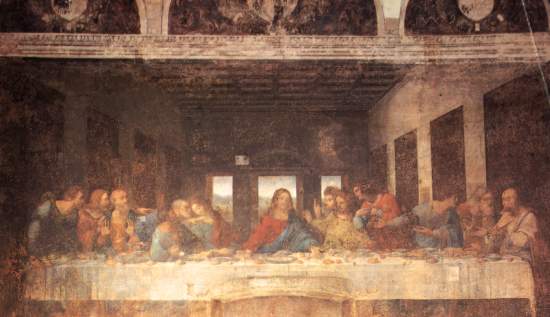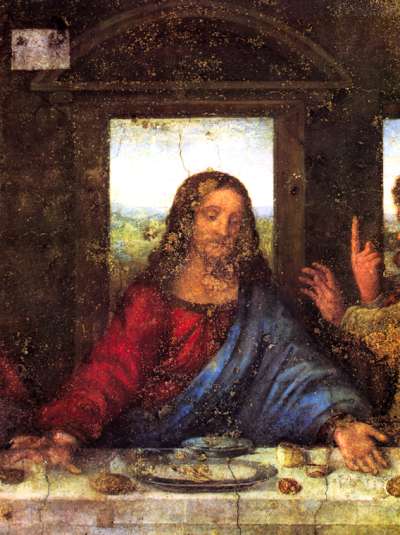The eighteen years that
Leonardo da Vinci spent at the court of
Ludovico il
Moro had such an impact on the history of Lombard art that the whole 16
th

century was affected. Leonardo started work on the fresco - judged by many the genius's
greatest work - in 1496 when he received a commission from Ludovico who, after having
enlarged the church of
Santa Maria delle Grazie,
decided to enlarge and decorate the Refectory (Dining Hall) of the adjacent Dominican
monastery. Leonardo's snail pace work on the fresco soon became legendary. In fact, in
a letter sent by Ludovico to
Marchesino Stampa dated June 29, 1497, Ludovico
specifies that "
we have made the heartfelt decision... to urge Leonardo the Florentine
to finish the work he has undertaken in the Refectory of Santa Maria delle Grazie".
Leonardo painted it using an unconventional technique, sometimes without letting of a
paintbrush the whole day long, other times not picking up a paintbrush for days at a
time. Unfortunately, this technique involving the use of tempera paint over a double
layer of plaster (rather then true fresco pigment which becomes part of the wall
itself) proved faulty, and the fresco, which could not withstand the dampness of the

wall it was painted on, was soon decaying. By 1568, the writer-artist
Vasari
could already write of a "
striking stain". This was due to moisture collecting
under the paint, causing the pigment layer to fall off, the formation of saltpetre and
the spreading of mould. The tempering of French mercenary troops in the 16
th
century followed by
Napoleon's soldiers in the 18
th century worsened
these inherent defects. Emerging miraculously unscathed from the August 1943 bombings
which meanwhile had completely destroyed the Refectory, the Last Supper was given the
best of modern restoration treatment to save it from total ruin (numerous past attempts
had miserably failed). Leonardo put great emphasis on the depth out of which the twilight
emanates to bathe the figures in its uniform glow. The whole scene is bathed in a diffuse,
gentle light coming partly from three windows at the far end of the room and partly
from the light at the front, which seems to come from the actual window in the real
room. The apostles are placed in a group of three along the horizontal plane of the
table whose centre is the fixed point of the Christ figure. All the lines of the
rigorously symmetrical composition converge on Him in perfect perspective, including
the gestures and glances of the apostles, each of whom is portrayed reacting
differently according to his psychological state, to the words of Christ: "
One of
you would betray me".

 century was affected. Leonardo started work on the fresco - judged by many the genius's
greatest work - in 1496 when he received a commission from Ludovico who, after having
enlarged the church of Santa Maria delle Grazie,
decided to enlarge and decorate the Refectory (Dining Hall) of the adjacent Dominican
monastery. Leonardo's snail pace work on the fresco soon became legendary. In fact, in
a letter sent by Ludovico to Marchesino Stampa dated June 29, 1497, Ludovico
specifies that "we have made the heartfelt decision... to urge Leonardo the Florentine
to finish the work he has undertaken in the Refectory of Santa Maria delle Grazie".
Leonardo painted it using an unconventional technique, sometimes without letting of a
paintbrush the whole day long, other times not picking up a paintbrush for days at a
time. Unfortunately, this technique involving the use of tempera paint over a double
layer of plaster (rather then true fresco pigment which becomes part of the wall
itself) proved faulty, and the fresco, which could not withstand the dampness of the
century was affected. Leonardo started work on the fresco - judged by many the genius's
greatest work - in 1496 when he received a commission from Ludovico who, after having
enlarged the church of Santa Maria delle Grazie,
decided to enlarge and decorate the Refectory (Dining Hall) of the adjacent Dominican
monastery. Leonardo's snail pace work on the fresco soon became legendary. In fact, in
a letter sent by Ludovico to Marchesino Stampa dated June 29, 1497, Ludovico
specifies that "we have made the heartfelt decision... to urge Leonardo the Florentine
to finish the work he has undertaken in the Refectory of Santa Maria delle Grazie".
Leonardo painted it using an unconventional technique, sometimes without letting of a
paintbrush the whole day long, other times not picking up a paintbrush for days at a
time. Unfortunately, this technique involving the use of tempera paint over a double
layer of plaster (rather then true fresco pigment which becomes part of the wall
itself) proved faulty, and the fresco, which could not withstand the dampness of the
 wall it was painted on, was soon decaying. By 1568, the writer-artist Vasari
could already write of a "striking stain". This was due to moisture collecting
under the paint, causing the pigment layer to fall off, the formation of saltpetre and
the spreading of mould. The tempering of French mercenary troops in the 16th
century followed by Napoleon's soldiers in the 18th century worsened
these inherent defects. Emerging miraculously unscathed from the August 1943 bombings
which meanwhile had completely destroyed the Refectory, the Last Supper was given the
best of modern restoration treatment to save it from total ruin (numerous past attempts
had miserably failed). Leonardo put great emphasis on the depth out of which the twilight
emanates to bathe the figures in its uniform glow. The whole scene is bathed in a diffuse,
gentle light coming partly from three windows at the far end of the room and partly
from the light at the front, which seems to come from the actual window in the real
room. The apostles are placed in a group of three along the horizontal plane of the
table whose centre is the fixed point of the Christ figure. All the lines of the
rigorously symmetrical composition converge on Him in perfect perspective, including
the gestures and glances of the apostles, each of whom is portrayed reacting
differently according to his psychological state, to the words of Christ: "One of
you would betray me".
wall it was painted on, was soon decaying. By 1568, the writer-artist Vasari
could already write of a "striking stain". This was due to moisture collecting
under the paint, causing the pigment layer to fall off, the formation of saltpetre and
the spreading of mould. The tempering of French mercenary troops in the 16th
century followed by Napoleon's soldiers in the 18th century worsened
these inherent defects. Emerging miraculously unscathed from the August 1943 bombings
which meanwhile had completely destroyed the Refectory, the Last Supper was given the
best of modern restoration treatment to save it from total ruin (numerous past attempts
had miserably failed). Leonardo put great emphasis on the depth out of which the twilight
emanates to bathe the figures in its uniform glow. The whole scene is bathed in a diffuse,
gentle light coming partly from three windows at the far end of the room and partly
from the light at the front, which seems to come from the actual window in the real
room. The apostles are placed in a group of three along the horizontal plane of the
table whose centre is the fixed point of the Christ figure. All the lines of the
rigorously symmetrical composition converge on Him in perfect perspective, including
the gestures and glances of the apostles, each of whom is portrayed reacting
differently according to his psychological state, to the words of Christ: "One of
you would betray me".